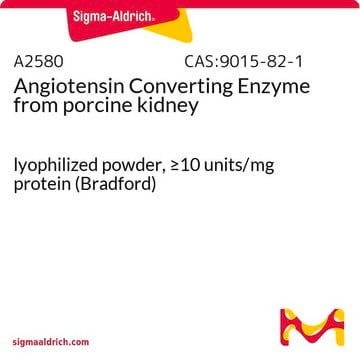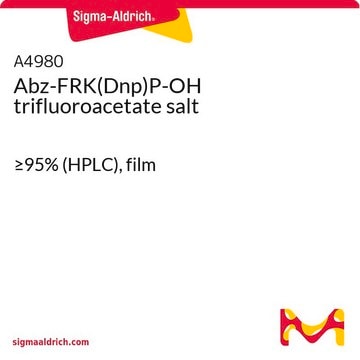Idrapril, the prototype of a new class of angiotensin converting enzyme (ACE) inhibitors, competitively inhibits, with nanomolar apparent Ki, the hydrolysis of hippuryl-glycyl-glycine by rabbit lung ACE. Kinetic Ki and kon and koff values were 470 pM, 3.0±1.5×106 M-1sec-1 and 1.4±0.3×10-3 sec-1, respectively. Reference: Biochemical Pharmacology, 45(6), 1358-1362 (1993).
A6778
Angiotensin Converting Enzyme from rabbit lung
≥2.0 units/mg protein (modified Warburg-Christian)
Synonym(s):
ACE, Peptidyl-dipeptidase A, Peptidyldipeptide Hydrolase
About This Item
Recommended Products
form
lyophilized powder
Quality Level
specific activity
≥2.0 units/mg protein (modified Warburg-Christian)
shipped in
dry ice
storage temp.
−20°C
Looking for similar products? Visit Product Comparison Guide
Related Categories
General description
Application
- for measuring inhibitory effect of egg white protein hydrolysates on ACE activity by high performance liquid chromatography (HPLC)[2]
- to measure the ACE inhibition by litchi pericarp[5] and cooked chicken breast[4] using hippuryl-L-histidyl-L-leucine (HHL) as substrate by reverse phase-HPLC (RP-HPLC)3 and HPLC[4] respectively
- in releasing GPI anchored protein in vitro in few cell lines like HeLa, HEK293 and in vivo in mice sperm.[1]
Biochem/physiol Actions
Quality
Unit Definition
inhibitor
substrate
Signal Word
Danger
Hazard Statements
Precautionary Statements
Hazard Classifications
Resp. Sens. 1
Storage Class Code
11 - Combustible Solids
WGK
WGK 3
Flash Point(F)
Not applicable
Flash Point(C)
Not applicable
Personal Protective Equipment
Choose from one of the most recent versions:
Certificates of Analysis (COA)
Don't see the Right Version?
If you require a particular version, you can look up a specific certificate by the Lot or Batch number.
Already Own This Product?
Find documentation for the products that you have recently purchased in the Document Library.
Customers Also Viewed
-
Are there any other known inhibitors of rabbit lung Angiotensin Converting Enzyme (ACE), Product A6778?
1 answer-
Helpful?
-
-
What is the Department of Transportation shipping information for this product?
1 answer-
Transportation information can be found in Section 14 of the product's (M)SDS.To access the shipping information for this material, use the link on the product detail page for the product.
Helpful?
-
-
What is the effect of bleomycin on Angiotensin Converting Enzyme (ACE) activity in vivo?
1 answer-
Bleomycin causes a marked reduction in rabbit lung ACE activity. Reference: Cancer Research, 40, 3621-3626, (1980).
Helpful?
-
-
What is the medical significance of Angiotensin Converting Enzyme (ACE), Product A6778?
1 answer-
Angiotensin-converting enzyme (ACE) produces angiotensin II, a substance that affects the cardiovascular system in numerous ways, including narrowing of blood vessels. This narrowing can cause high blood pressure and cause the heart to work harder. ACE inhibitors treat a variety of conditions, such as high blood pressure, scleroderma and migraines. (Mayo Clinic)
Helpful?
-
Active Filters
Our team of scientists has experience in all areas of research including Life Science, Material Science, Chemical Synthesis, Chromatography, Analytical and many others.
Contact Technical Service






![N-[3-(2-Furyl)acryloyl]-Phe-Gly-Gly](/deepweb/assets/sigmaaldrich/product/structures/225/349/530bc714-b1a8-4fdb-8082-a39329ee730a/640/530bc714-b1a8-4fdb-8082-a39329ee730a.png)







